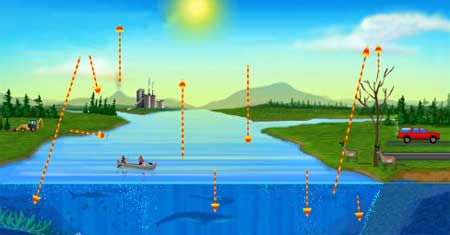Global Climate Change and Energy Carbon Dioxide Sources
Carbon Dioxide (CO2) has been entering the atmosphere from many sources for millions of years. One of these sources—the burning of fossil fuels by humans—began with the Industrial Revolution. It is now a big source of carbon dioxide and is having a major effect on the balance of the carbon cycle.
Let's see where the CO2 in the atmosphere is coming from.
Respiration
Animals extract oxygen from the air they breathe. It is combined with sugars producing energy, CO2, and water. Fish and other water creatures extract the dissolved oxygen from the water in which they live. Respiration occurs in plants as well. They need energy to grow. Green plants are both CO2 sources, because of respiration, and CO2 sinks, because of photosynthesis.
Decay
When plants and animals die they begin to undergo chemical processes that break down the organic compounds they are made of into simpler compounds, including CO2.
Volcanoes
Volcanic eruptions produce solid and gaseous emissions that include CO2.
Diffusion out of the Oceans
Dissolved CO2 is released into the air from the oceans. As explained above, this is part of a two-way process in which CO2 is also absorbed by the oceans. Currently there is more CO2 being absorbed than is being released. The oceans are a net CO2 sink at this time.
Human Interventions
|
Some human activities affect the amount of CO2 flowing into and out of the atmosphere, as shown here: cement production, power plants that burn fossil fuels, automobiles, and deforestation. The image depicts a hypothetical situation in which the net flow of CO2 into and out of the atmosphere is zero. That is, the flows are in balance and there is no net increase or decrease in atmospheric CO2. Click on the image for an animation that allows you to affect the balance. |
Human activities have an effect on the flow of CO2 into and out of the atmosphere. Over the past 150 years these effects have increased significantly.
Burning fossil fuels
Coal is almost pure carbon, and oil and natural gas (hydrocarbons) are mostly carbon. We burn these in oxygen (from the air) to produce power for heat, light, and transport. The burning of fossil fuels currently releases about 26 billion metric tons (28.7 billion U.S. tons) of CO2 into the atmosphere every year.
Cement production
About 5% of human-related CO2 released into the atmosphere is from the production of cement, which involves crushing and baking carbonate rocks such as limestone and chalk. These rocks are also used in the production of iron and steel and other industrial processes.
Deforestation
For centuries, people have burned forests to clear land for agriculture. This affects the CO2 balance in two ways. First, the burning releases CO2 into the atmosphere. Second, the number of trees that can remove CO2 by photosynthesis is reduced. It is true that agricultural land is also a CO2 sink, but it is not as effective as forests.
There is also significant deforestation as a result of cutting trees for lumber. This does not add CO2 to the atmosphere because the trees are not burned, but the CO2 sink provided by forest cover is reduced.
What's the Result?
Human activity is making a significant contribution to the amount of CO2 in the atmosphere. Current projections are that this CO2 production will continue to increase in years to come. Find out more…
How Is CO2 Removed from the Atmosphere?
A carbon sink is something that removes carbon from the atmosphere. Find out more…
This content has been re-published with permission from SEED. Copyright © 2025 Schlumberger Excellence in Education Development (SEED), Inc.


